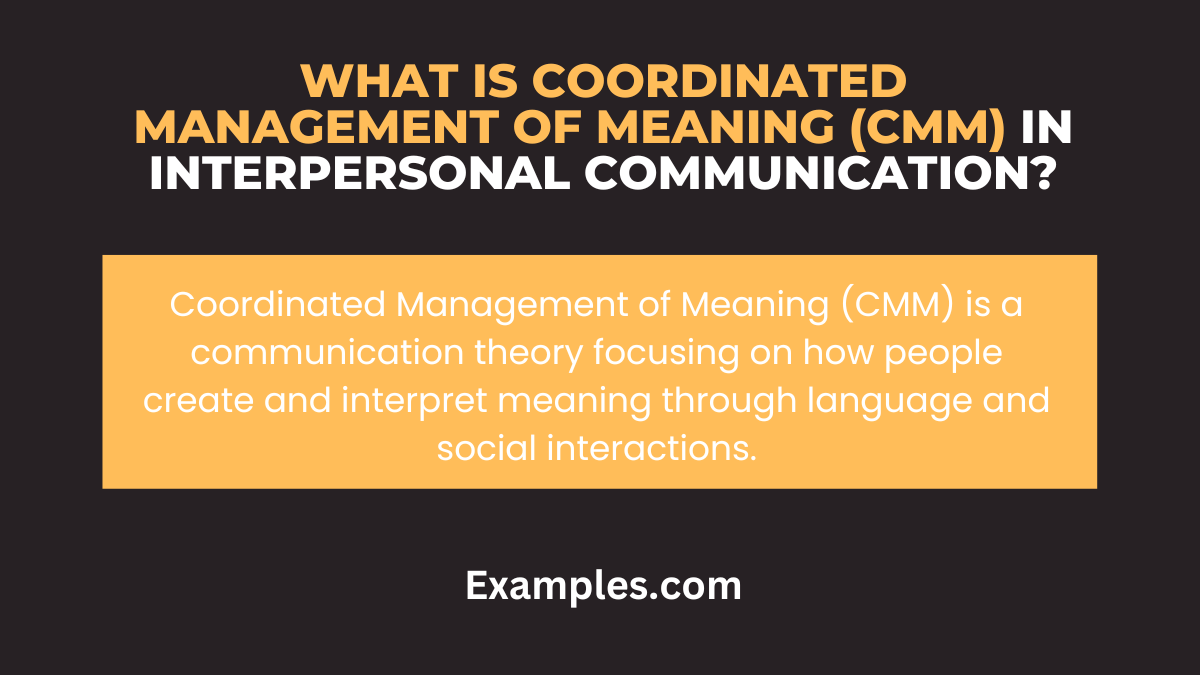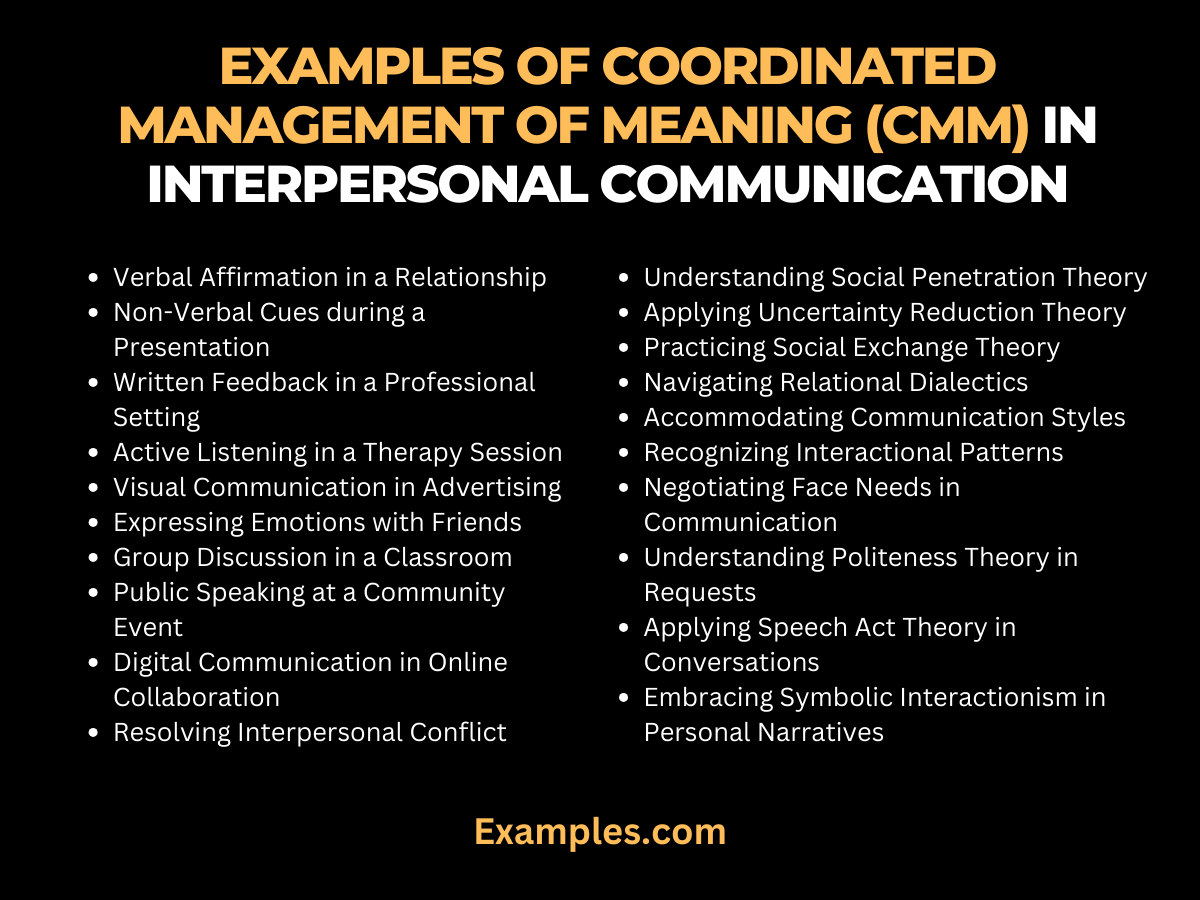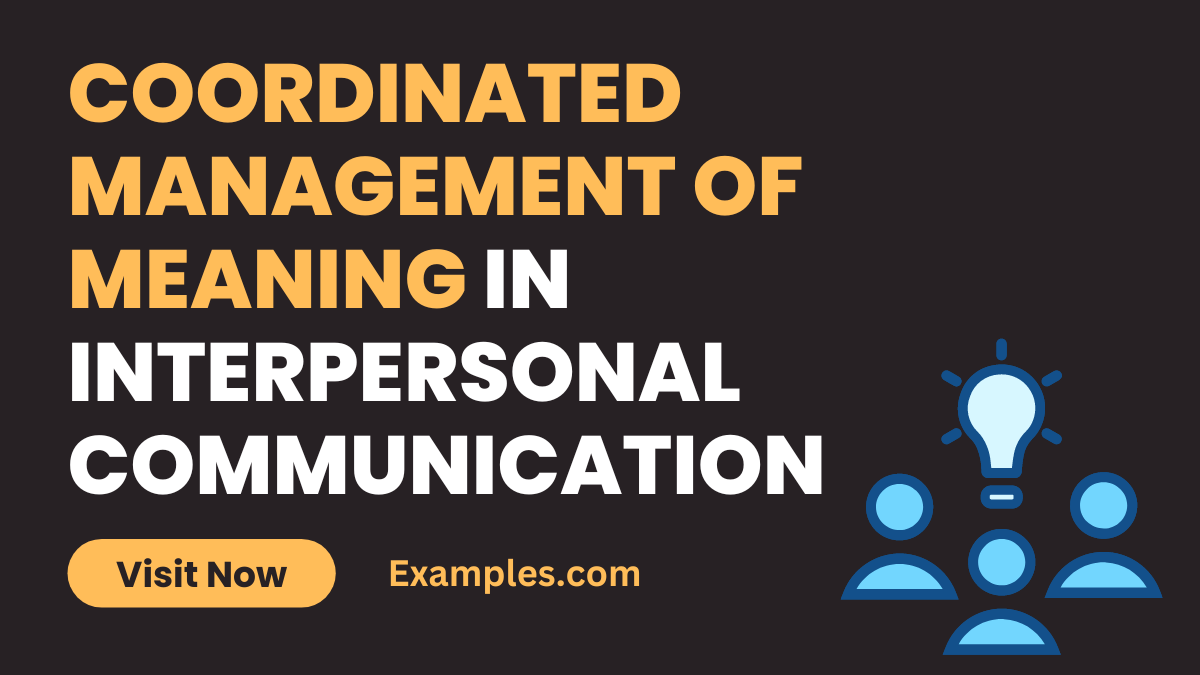19+ Coordinated Management of Meaning (CMM) in Interpersonal Communication Examples
Dive into the world of Interpersonal Communication through the lens of Coordinated Management of Meaning (CMM). This comprehensive guide provides insightful examples and practical applications of CMM, offering a deeper understanding of how our conversations shape our reality. Perfect for those seeking to enhance their communication skills, this guide illuminates the intricate processes involved in constructing meaningful interactions.
What is Coordinated Management of Meaning (CMM) in Interpersonal Communication?

Coordinated Management of Meaning (CMM) in interpersonal communication is a theory that explores how individuals create, negotiate, and modify meanings in their conversational exchanges. It emphasizes the role of context and social norms in shaping the interpretation and understanding of messages. CMM helps us comprehend how our interactions contribute to our shared realities.
History
Who Created: W. Barnett Pearce and Vernon Cronen
Date: 1970
The Coordinated Management of Meaning (CMM) theory, developed by W. Barnett Pearce and Vernon Cronen, offers profound insights into how individuals create, coordinate, and manage meanings in conversation. This theory underscores the complexity of interpersonal communication, emphasizing that in conversations, people co-construct their own social realities and are simultaneously shaped by the worlds they create.
What is the Best Example of Coordinated Management of Meaning (CMM) in Interpersonal Communication?
A classic example of CMM is a job interview. The interviewer and interviewee engage in a dance of questions and answers, each interpreting and adjusting their responses based on perceived meanings and expectations. This interaction illustrates how CMM operates in creating a shared understanding or potentially leading to miscommunication.
20 Examples of Coordinated Management of Meaning (CMM) in Interpersonal Communication

Understanding Coordinated Management of Meaning (CMM) in Interpersonal Communication is crucial for effective exchange of ideas and feelings. It involves analyzing how individuals construct and interpret messages in various contexts. These 20 examples demonstrate how CMM can be applied in different types of Interpersonal Communication, offering insights into verbal, non-verbal, emotional, and digital interactions. This knowledge is essential for enhancing communication skills and understanding the dynamics of interpersonal relationships.
- Verbal Affirmation in a Relationship: This acknowledges the partner’s effort, reinforcing positive interaction.
Example: “I appreciate you listening to me; it makes me feel valued. - Non-Verbal Cues during a Presentation: These non-verbal signals enhance the clarity and engagement of the presentation.
Example: A speaker maintains eye contact and uses hand gestures for emphasis. - Written Feedback in a Professional Setting: Constructive feedback fosters a productive and respectful work environment.
Example: “Your report was well-researched; let’s discuss further improvements.” - Active Listening in a Therapy Session: Validates the client’s feelings and encourages open communication.
Example: Therapist nods and says, “I understand your perspective.” - Visual Communication in Advertising: Visual elements effectively communicate the intended message to a broad audience.
Example: A billboard uses powerful imagery to convey a social message. - Expressing Emotions with Friends: Sharing emotions strengthens bonds and mutual understanding among friends.
Example: “I feel relieved sharing this with you; your support means a lot.” - Group Discussion in a Classroom: Promotes inclusivity and respect for diverse opinions in small group settings.
Example: Students take turns speaking, ensuring everyone’s voice is heard. - Public Speaking at a Community Event: Personal anecdotes make the message more accessible and engaging.
Example: The speaker uses relatable stories to connect with the audience. - Digital Communication in Online Collaboration: Ensures effective and efficient information exchange in a digital environment.
Example: Team members use clear and concise language in emails and chats. - Resolving Interpersonal Conflict: Promotes collaboration and mutual respect in conflict resolution.
Example: “Let’s find a solution that works for both of us.” - Understanding Social Penetration Theory: Reflects the process of developing deeper intimacy over time.
Example: Gradually sharing personal information as trust builds in a new friendship. - Applying Uncertainty Reduction Theory: Helps reduce uncertainty in early stages of relationship formation.
Example: Asking open-ended questions to know someone better. - Practicing Social Exchange Theory: Illustrates the give-and-take nature of social interactions.
Example: Offering help to a colleague with the expectation of future support. - Navigating Relational Dialectics: Reflects the ongoing negotiation of opposing needs in close relationships.
Example: Balancing the need for independence and connection in a relationship. - Accommodating Communication Styles: Enhances comprehension and rapport in diverse communication situations.
Example: Adapting your language to match the listener’s level of understanding. - Recognizing Interactional Patterns: Helps break negative cycles and foster healthier communication.
Example: Identifying and addressing repetitive arguments in a relationship. - Negotiating Face Needs in Communication: Balances the need to provide feedback with the desire to maintain harmony.
Example: Offering criticism gently to avoid offending the other person. - Understanding Politeness Theory in Requests: Softens the request, showing respect for the other person’s autonomy.
Example: “Would you mind helping me with this task?” - Applying Speech Act Theory in Conversations: Demonstrates how language can be used to accomplish specific actions.
Example: Using indirect language to make a suggestion instead of a direct order. - Embracing Symbolic Interactionism in Personal Narratives: Highlights how individual experiences shape communication and self-concept.
Example: Sharing stories that reflect personal values and identity.
What are the Models of Coordinated Management of Meaning (CMM) in Interpersonal Communication?
The Coordinated Management of Meaning (CMM) in Interpersonal Communication is a significant concept that offers insightful perspectives on how individuals create, coordinate, and manage meanings in their everyday interactions. Understanding the models of CMM is crucial for anyone keen on enhancing their Interpersonal Communication Skills.
Hierarchical Model of Organizing Meaning
The Hierarchical Model is a fundamental aspect of CMM. It illustrates how meaning is organized across different levels, starting from content (specific words used) to speech acts (actions performed through words), episodes (contexts of communication), relationships (nature of connections between communicators), life scripts (individual’s self-concept), and cultural patterns (broad societal norms and values). This model emphasizes the layers of understanding that contribute to the overall meaning in communication.
Reflexivity
Reflexivity in CMM refers to the ability of individuals to reflect on their communication and adapt it according to the feedback or context. It involves being aware of the impact of one’s communication style and adjusting it to manage meanings more effectively.
Coordination
Coordination is the process by which individuals align their actions and communications to co-create a shared social reality. It involves mutual understanding and agreement on the meanings of words and actions within a specific context.
Management
Management in CMM is about how individuals negotiate, modify, and co-create meanings in their interactions. It focuses on the dynamic aspect of communication, where meanings are not fixed but are constantly being shaped and reshaped through interaction.
Contextual Model
This model focuses on the context in which communication occurs. It suggests that the meaning of a message can be fully understood only by considering the situational, relational, and cultural contexts. This model highlights the importance of understanding the background and circumstances under which communication takes place.
What are the Processes of Coordinated Management of Meaning (CMM) in Interpersonal Communication?
Understanding the processes involved in the Coordinated Management of Meaning is essential for effectively navigating various Types of Interpersonal Communication.
Mutual Circumspection
Mutual Circumspection refers to the careful consideration and attentiveness individuals must have towards each other’s words and actions. This process involves being aware of how one’s communication might be interpreted and how it impacts the overall conversation.
Charmed and Strange Loops
These loops in CMM represent the complex nature of communication patterns. Charmed loops refer to consistent and reinforcing patterns of communication, while strange loops signify paradoxical and conflicting patterns. Recognizing these loops can help in understanding the complexities in communication dynamics.
Stories Lived and Stories Told
In CMM, stories lived are the actual experiences and actions of individuals, while stories told are the narratives we create to make sense of our experiences. The alignment or misalignment between these two can significantly affect interpersonal relationships and communication effectiveness.
Unwanted Repetitive Patterns (URPs)
URPs are recurring negative communication patterns that can hinder effective communication. Identifying and addressing these patterns is crucial for improving communication dynamics.
Constructing Social Realities
This process involves how individuals, through their communication, construct their shared social realities. It emphasizes the power of communication in shaping our perception of the world around us.
Coordinated Management of Meaning (CMM) focuses on how we co-create meaning in our interactions. It teaches the value of aligning our narratives and interpretations for effective communication. Implement this theory by actively engaging in shared meaning-making, clarifying misunderstandings, and respecting different perspectives. This approach fosters deeper understanding and more effective, empathetic communication.



